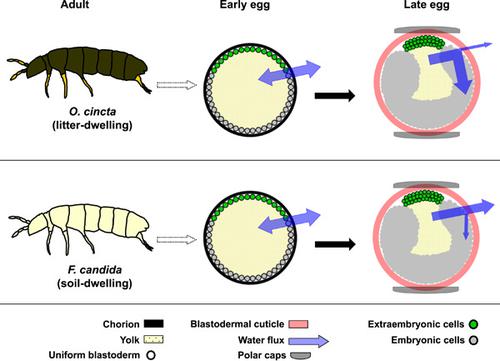当前位置:
X-MOL 学术
›
J. Exp. Zool. B Mol. Dev. Evol.
›
论文详情
Our official English website, www.x-mol.net, welcomes your
feedback! (Note: you will need to create a separate account there.)
Increase in egg resistance to desiccation in springtails correlates with blastodermal cuticle formation: Eco-evolutionary implications for insect terrestrialization
Journal of Experimental Zoology-B: Molecular and Developmental Evolution ( IF 1.8 ) Pub Date : 2020-07-10 , DOI: 10.1002/jez.b.22979 Helena C M Vargas 1, 2 , Kristen A Panfilio 3 , Dick Roelofs 2 , Gustavo L Rezende 1, 3, 4
Journal of Experimental Zoology-B: Molecular and Developmental Evolution ( IF 1.8 ) Pub Date : 2020-07-10 , DOI: 10.1002/jez.b.22979 Helena C M Vargas 1, 2 , Kristen A Panfilio 3 , Dick Roelofs 2 , Gustavo L Rezende 1, 3, 4
Affiliation

|
Land colonization was a major event in the history of life. Among animals, insects exerted a staggering terrestrialization success, due to traits usually associated with postembryonic life stages, while the egg stage has been largely overlooked in comparative studies. In many insects, after blastoderm differentiation, the extraembryonic serosal tissue wraps the embryo and synthesizes the serosal cuticle, an extracellular matrix that lies beneath the eggshell and protects the egg against water loss. In contrast, in noninsect hexapods such as springtails (Collembola) the early blastodermal cells synthesize a blastodermal cuticle. Here, we investigate the relationship between blastodermal cuticle formation and egg resistance to desiccation in the springtails Orchesella cincta and Folsomia candida, two species with different oviposition environments and developmental rates. The blastodermal cuticle becomes externally visible in O. cincta and F. candida at 22% and 29% of embryogenesis, respectively. To contextualize, we describe the stages of springtail embryogenesis, exemplified by F. candida. Our physiological assays then showed that blastodermal cuticle formation coincides with an increase in egg viability in a dry environment, significantly contributing to hatching success. However, protection differs between species: while O. cincta eggs survive at least 2 hr outside a humid environment, the survival period recorded for F. candida eggs is only 15 min, which correlates with this species’ requirement for humid microhabitats. We suggest that the formation of this cuticle protects the eggs, constituting an ancestral trait among hexapods that predated and facilitated the process of terrestrialization that occurred during insect evolution.
中文翻译:

弹尾虫卵对干燥的抗性增加与胚层角质层形成相关:昆虫陆地化的生态进化意义
土地殖民化是生活史上的一件大事。在动物中,由于通常与胚胎后生命阶段相关的特征,昆虫取得了惊人的陆地化成功,而在比较研究中,卵阶段在很大程度上被忽视了。在许多昆虫中,胚层分化后,胚外浆膜组织包裹胚胎并合成浆膜角质层,浆膜角质层是一种位于蛋壳下方的细胞外基质,可保护鸡蛋免受水分流失。相反,在非昆虫六足动物中,如跳虫(跳虫),早期胚层细胞合成胚层角质层。在这里,我们研究了弹尾 Orchesella cincta和Folsomia candida,两种产卵环境和发育速度不同的物种。胚层角质层在O. cincta和F. candida中分别在胚胎发生的 22% 和 29% 时变得外部可见。为了背景化,我们描述了以假丝酵母菌为例的跳尾胚胎发生的阶段。然后,我们的生理测定表明,胚层角质层的形成与干燥环境中卵子活力的增加相吻合,这对孵化成功有显着贡献。然而,保护因物种而异:虽然O. cincta卵在潮湿环境外至少能存活 2 小时,但F. candida记录的存活期卵只有 15 分钟,这与该物种对潮湿微生境的需求有关。我们认为这种角质层的形成保护了卵,构成了六足动物的祖先特征,该特征早于并促进了昆虫进化过程中发生的陆地化过程。
更新日期:2020-07-10
中文翻译:

弹尾虫卵对干燥的抗性增加与胚层角质层形成相关:昆虫陆地化的生态进化意义
土地殖民化是生活史上的一件大事。在动物中,由于通常与胚胎后生命阶段相关的特征,昆虫取得了惊人的陆地化成功,而在比较研究中,卵阶段在很大程度上被忽视了。在许多昆虫中,胚层分化后,胚外浆膜组织包裹胚胎并合成浆膜角质层,浆膜角质层是一种位于蛋壳下方的细胞外基质,可保护鸡蛋免受水分流失。相反,在非昆虫六足动物中,如跳虫(跳虫),早期胚层细胞合成胚层角质层。在这里,我们研究了弹尾 Orchesella cincta和Folsomia candida,两种产卵环境和发育速度不同的物种。胚层角质层在O. cincta和F. candida中分别在胚胎发生的 22% 和 29% 时变得外部可见。为了背景化,我们描述了以假丝酵母菌为例的跳尾胚胎发生的阶段。然后,我们的生理测定表明,胚层角质层的形成与干燥环境中卵子活力的增加相吻合,这对孵化成功有显着贡献。然而,保护因物种而异:虽然O. cincta卵在潮湿环境外至少能存活 2 小时,但F. candida记录的存活期卵只有 15 分钟,这与该物种对潮湿微生境的需求有关。我们认为这种角质层的形成保护了卵,构成了六足动物的祖先特征,该特征早于并促进了昆虫进化过程中发生的陆地化过程。











































 京公网安备 11010802027423号
京公网安备 11010802027423号